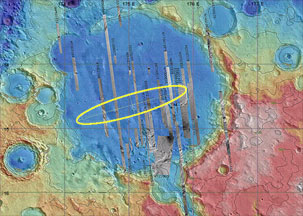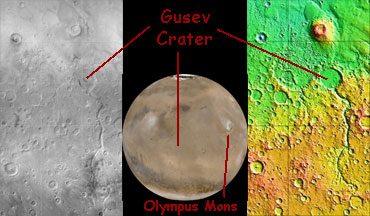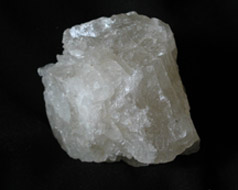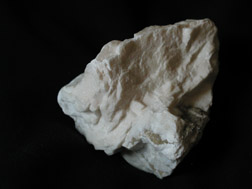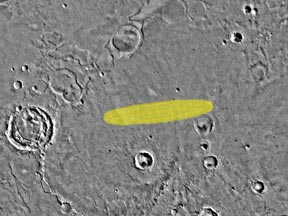Click on image for full size
NASA
MER Spirit landing site - Gusev Crater
The first of two Mars Exploration Rovers (MER) landed within Gusev Crater on Mars on January 3, 2004. The robotic rover, named Spirit, bounced to a halt within an 81 km by 12 km (50 by 7 miles) target landing ellipse inside the ancient crater. Once settled into its new "home", Spirit began its mission of exploring for geologic evidence of the presence of water in Gusev Crater's past.
The MER vehicles are robotic field geologists especially designed to detect rocks and soils that might indicate that liquid water was once present at their landing sites on Mars. Gusev Crater, formed by the impact of an asteroid three to four billion years ago, may have held a large lake in the distant past. A valley named Ma'adim Vallis, which is connected to the south side of the crater, looks like it may have been a river channel that poured water into the ancient lake. If that is the case, Gusev Crater should show signs of the former presence of water in its rock and soil formations.
MER mission scientists hope to find layered, sedimentary deposits indicating deposition of materials by flowing water. They are also looking for types of rocks and minerals called evaporites that form on Earth when water dries up, leaving the minerals it contains behind. For example, evaporation of salty water produces deposits of the mineral halite. Gypsum or calcium magnesian sulfate are other types of evaporites. MER is looking for carbonates (such as calcium carbonate), which also form in the presence of water and often indicate that living organisms were present. Wet environments are the best places to look for life, which is why scientists are so eager to track down places on Mars that were once wet.
Gusev Crater is about 145 km (90 miles) wide and covers an area roughly the size of the state of Connecticut. It is located at 14.6° South latitude and 175.3° East longitude on Mars. The other MER rover, Opportunity, is exploring an area on Mars named Meridiani Planum on the opposite side of the Red Planet.


